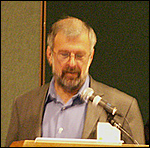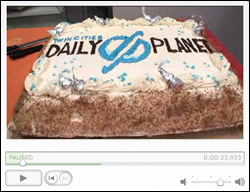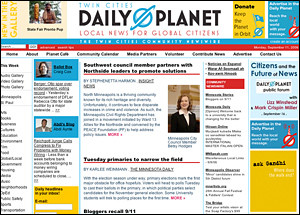San Francisco
 Jeremy Iggers
Jeremy Iggers
Founder, Twin Cities Daily Planet
Thank you.
I’d like to tell you a little bit about the Twin Cities Daily Planet, and as Jan said we started with support from J-Lab from their New Voices project.
The idea for the Daily Planet came partly out of the frustration that I was feeling – and that I think a lot of people who work for newspapers feel – with the direction that newspapers were headed, and it also came from hearing about an innovative online newspaper in South Korea called OhmyNews, which has grown enormously in the last few years and now has something like 50 professional journalists on staff and over 40,000 citizen journalists.
And I found myself wondering how you could create something like that in the United States, and it seemed to me that maybe the place to start was by creating a community-based non-profit. So I got some friends together to create the Twin Cities Media Alliance with the mission of improving the quality, diversity and accountability of the local media. Soon thereafter we applied for our grant from J-Lab and that helped us to actually launch the Daily Planet.
It came about at a time when major media outlets like the Star Tribune are focusing their energy more on attracting young readers, on attracting suburban readers, and I think part of our feeling was that the interests and concerns of urban communities and especially of our rapidly growing immigrant and ethnic communities were being given less attention.
This is a slide or two from the Readership Institute study of how to attract young readers. Their focus came to be on the experienced newspaper and as they say, I think urban and ethnic and immigrant concerns got secondary attention.
Here’s a quick view of OhmyNews, which is one of the inspirations for the Daily Planet. You’ll see up in the corner there’s the little banner that says, “Who says pros are the only real reporters?” And that’s a question we try to answer with the Daily Planet.
Here’s a quick look at our Daily Planet Web site. I hope you’ll all take time to look at it on your own. It’s www.tcdailyplanet.net.
Before I go into more detail about the Daily Planet I wanted to show a video.
 The Daily Planet actually went online last September and in the months that followed our managing editor, Craig Cox, created a partnership with over 40 neighborhood and community media, including some neighborhood publications, including KFAI Radio and a lot of ethnic and immigrant media. Then finally on May 1 of this year we had our official launch of the Web site and one of our media partners, a guy named Chuck Olson, who does a site called MNStories was on hand to document it, and here’s the video that he made for the occasion.
The Daily Planet actually went online last September and in the months that followed our managing editor, Craig Cox, created a partnership with over 40 neighborhood and community media, including some neighborhood publications, including KFAI Radio and a lot of ethnic and immigrant media. Then finally on May 1 of this year we had our official launch of the Web site and one of our media partners, a guy named Chuck Olson, who does a site called MNStories was on hand to document it, and here’s the video that he made for the occasion.
So what we’ve done is create a partnership with over 40 neighborhood and community media and I was just going to show you some of the examples. A lot of them do terrific journalism that reaches a very small audience. Some of them have non-functional Web sites and a lot of them are distributed in very small geographic areas. Hmong Today does terrific work and you only find their paper in a certain part of the University Avenue corridor in St. Paul, basically.
The Spokesman-Recorder is an African American paper with a wonderful long history that really struggles, and we’ve helped them reach a larger audience.
La Prensa de Minnesota is a rapidly growing publication. They’ve just started doing everything in this publication bilingually and we’re able to present their stories to a larger audience.
We’re also actively trying to recruit citizen journalists. You can become a citizen journalist, and we offer training. Doug McGill, whom you saw in the video, a former reporter for the New York Times and former Bloomberg bureau chief, has been running citizen journalism training classes through a local organization called the Resource Center of the Americas.
This is how some of their stories look when they appear in the Daily Planet. This is a story by Wameng Moua who is the editor and publisher and everything else for Hmong Today. He also just recently joined our Board of Directors.
 This is a story from La Prensa de Minnesota. This is a wonderful story if you dig it up in our archives. Marco Fernandez Landoni, who is the editor of La Prensa, was called in because there was a sort of fraudulent raid being conducted by the INS.
This is a story from La Prensa de Minnesota. This is a wonderful story if you dig it up in our archives. Marco Fernandez Landoni, who is the editor of La Prensa, was called in because there was a sort of fraudulent raid being conducted by the INS.
This is a story from the Spokesman-Recorder – I’m just going to quickly fly through these. This is a story by Abdirahman Ceynte.
Here are some of the developments that are coming along. One is that the city of Minneapolis is in the process of awarding a contract to do city-wide WiFi, has narrowed it down to two vendors, and one of the vendors, a company called US Internet, has invited us to be their local news provider on their pilot project portal. So it looks like we’re going to be part of the WiFi future and we may also be involved in hyperlocal news.
WiFi is done through hundreds of transmitters on telephone poles, and we’ll be able to send you very site-specific information based on your neighborhood and based on the information we get about where you’re going online.
As far as citizen journalism training, this is the site run by Doug McGill who does our citizen journalism training, and here’s his citizen journalism training manual, and I just put in a little bit of his curriculum here. He’s developed a very elaborate syllabus. He taught a six-session, three hours per session course that’s almost the equivalent of a college intro to journalism course to a very diverse enrollment at the Resource Center of the Americas. I think when he announced that he was going to charge $100 we figured that would really knock out the enrollment but it was oversubscribed and a very diverse group.
A local foundation called the Headwaters Foundation agreed to underwrite the tuition for any of its grantees who wanted to take the class, and the students who participated in his class both had their stories posted on the class blog, which is called the RCA Muckraker, and that same story I think also appeared on the daily planet.
JAN SCHAFFER: Talk about the reaction in the community to this, both in the media community and in the civic community.
JEREMY IGGERS: The reaction in the civic community has been overwhelmingly positive. Our mayor, R.T. Reibach, gave a presentation on technology to the annual non-profits conference and put in a big plug for the Daily Planet.
I think there’s a real perception that the Twin Cities have grown from being one of the most homogeneous communities in the United States to being – I don’t now if it’s one of the most diverse now – but there’s been an explosion of diversity in the Twin Cities and yet a lot of the new communities in the Twin Cities are largely invisible in the major media. So I think there’s a real recognition that there’s a need for creating bridges and helping people, especially in helping people from sort of the mainstream community understand the concerns and the issues in our new immigrant communities, especially Somali and Hmong and Latino.
We’ve gotten enormously positive feedback on that score.
The reaction from the media community – I’m going to have to say this very diplomatically: When we first got the grant from J-Lab about a year ago I sent a note to my editors at the Star Tribune saying that we’d gotten the grant to start a local news Web site and I got back a note that said in effect, “Oh, that’s nice.”
So we proceeded with our plans and developed the site and hired our managing editor and then that editor was replaced so I sent a note to her replacement and said, “We’re starting this local news Web site,” and got back a note that said, “Thanks for the heads up, I’ll look into this and get back to you.”
And to make a long story short, management at the Star Tribune sort of ignored the project, and then once it launched in a fairly big way and was obviously getting a lot of local media attention, they sent me a note saying, “We don’t think you should be doing this,” and suggested that it might be in violation of the guild contract.
I recruited somebody from the guild to assist me and we had a couple of fairly intense conversations but the upshot of it is I tried to make the case to my editors at the Star Tribune that this was something that could in fact be an enormously valuable resource in reaching new and immigrant and ethnic communities, and by the last meeting they were expressing a real interest in exploring that, I think, and in finding ways that they could use the Daily Planet as a resource.
Now in terms of other local media, we’ve been talking to the local NBC affiliate, KARE 11 – and it’s supposed to be up by now but I guess that will happen next week – that they’re going to put headlines from the Daily Planet on their Web site every day, and also they are inviting our managing editor to appear on their sunrise show every other week. So we are getting some of the stories from our media partners out into the mainstream media.
AUDIENCE QUESTION: Are your editors and reporters paid? If so, how much, and where does the money come from to pay them?
JEREMY IGGERS: Our initial funding came from J-Lab, we’ve since then gotten a $20,000 grant from a local foundation – the Otto Bremer Foundation – a $10,000 grant from a small family foundation and we just keep hoping and praying and “passing the hat.”
We’re not paying any of our reporters yet. We’re paying one person – I initially hired Craig [Cox] as a quarter-time managing editor, he’s now gone up to half-time and we’ve since hired an operations manager, and I’m sort of the fulltime grant writer when I’m not working my day job.
We’re just keeping our fingers crossed and we hope that if we establish ourselves as being really useful and valuable to the community that the money will follow, and we’re trying to develop an advertising consortium that will bring in some revenue.
Our basic business model is sort of the public radio model, and we’re trying to build a base of reader supporters who will send us $20 or $50 or $100 in return for a T-shirt or some bumper stickers or something and then a group of individual donors who might write bigger checks, and then some money from foundations and some money from underwriting or advertising.
AUDIENCE QUESTION: Five years from now, what need will there be for the Minneapolis Star Tribune?
JEREMY IGGERS: I think that the Star Tribune is a smart organization. It’s going to continue to reinvent itself. I think that’s a question that people there are worrying about, and I don’t know, I think if they’re smart they are going to be an innovative organization that is going to take advantage of resources like the Daily Planet.
I don’t think the Daily Planet will ever replace the Star Tribune – I think there’s enough breadth in the market – but I think they are going to have to find ways of reaching into the newest parts of their community.
Continue to Lew Friedland’s Presentation






